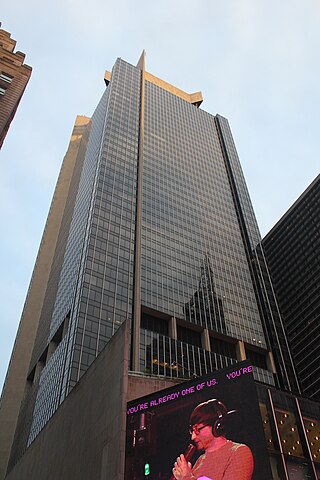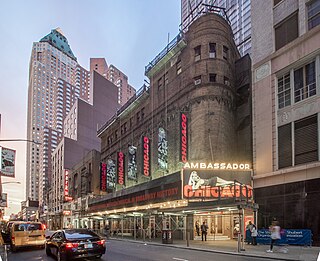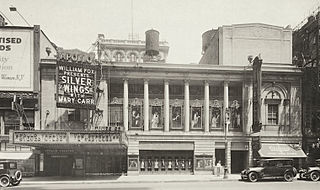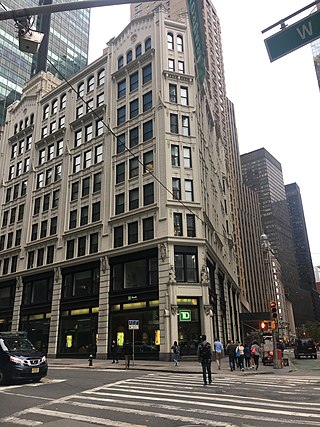
The Bernard B. Jacobs Theatre is a Broadway theater at 242 West 45th Street in the Theater District of Midtown Manhattan in New York City. Opened in 1927, the theater was designed by Herbert J. Krapp in a Spanish style and was built for real-estate developer Irwin S. Chanin. It has 1,100 seats across two levels and is operated by The Shubert Organization. Both the facade and the auditorium interior are New York City landmarks.

The Hayes Theater is a Broadway theater at 240 West 44th Street in the Theater District of Midtown Manhattan in New York City. Named for actress Helen Hayes, the venue is operated by Second Stage Theater. It is the smallest Broadway theater, with 597 seats across two levels. The theater was constructed in 1912 for impresario Winthrop Ames and designed by Ingalls & Hoffman in a neo-Georgian style. The original single-level, 299-seat configuration was modified in 1920, when Herbert J. Krapp added a balcony to expand the Little Theatre. The theater has served as a legitimate playhouse, a conference hall, and a broadcasting studio throughout its history.

One Astor Plaza, also known as 1515 Broadway and formerly the W. T. Grant Building, is a 54-story office building on Times Square in the Theater District of Midtown Manhattan in New York City. Designed by Der Scutt of Ely J. Kahn & Jacobs, the building was developed by Sam Minskoff and Sons. One Astor Plaza occupies a site bounded by Broadway to the east, 45th Street to the north, Shubert Alley to the west, and 44th Street to the south. The building is named for the Hotel Astor, which had occupied the site from 1904 to 1967. SL Green Realty and Allianz own One Astor Plaza, which as of 2022 serves as the headquarters for Paramount Global.

The Broadway Theatre is a Broadway theater at 1681 Broadway in the Theater District of Midtown Manhattan in New York City. Opened in 1924, the theater was designed by Eugene De Rosa for Benjamin S. Moss, who originally operated the venue as a movie theater. It has approximately 1,763 seats across two levels and is operated by The Shubert Organization. The Broadway Theatre is one of the few Broadway theaters that is physically on Broadway.

The Lunt-Fontanne Theatre, originally the Globe Theatre, is a Broadway theater at 205 West 46th Street in the Theater District of Midtown Manhattan in New York City. Opened in 1910, the Lunt-Fontanne Theatre was designed by Carrère and Hastings in the Beaux-Arts style for Charles Dillingham. The theater is named after theatrical couple Alfred Lunt and Lynn Fontanne; its original name was inspired by that of the Globe Theatre, London's Shakespearean playhouse. The current configuration of the interior, dating to 1958, has about 1,505 seats across two levels and is operated by the Nederlander Organization. The facade is a New York City landmark.

The Longacre Theatre is a Broadway theater at 220 West 48th Street in the Theater District of Midtown Manhattan in New York City, United States. Opened in 1913, it was designed by Henry B. Herts and was named for Longacre Square, now known as Times Square. The Longacre has 1,077 seats and is operated by The Shubert Organization. Both the facade and the auditorium's interior are New York City designated landmarks.

The John Golden Theatre, formerly the Theatre Masque and Masque Theater, is a Broadway theater at 252 West 45th Street in the Theater District of Midtown Manhattan in New York City. Opened in 1927, the Golden Theatre was designed by Herbert J. Krapp in a Spanish style and was built for real-estate developer Irwin S. Chanin. It has 800 seats across two levels and is operated by the Shubert Organization. Both the facade and the auditorium interior are New York City landmarks.

The Lyric Theatre is a Broadway theater at 214 West 43rd Street in the Theater District of Midtown Manhattan in New York City. Opened in 1998, the theater was designed by Richard Lewis Blinder of Beyer Blinder Belle, in collaboration with Peter Kofman, for Garth Drabinsky and his company Livent. The Lyric Theatre was built using parts of two former theaters on the site: the Apollo Theatre, built in 1920 to a design by Eugene De Rosa, and the old Lyric Theatre, built in 1903 to a design by Victor Hugo Koehler. The theater contains 1,622 seats across three levels and is operated by Ambassador Theatre Group (ATG). The theater building is owned by the city and state governments of New York and was developed by New 42nd Street.

The Belasco Theatre is a Broadway theater at 111 West 44th Street, between Seventh Avenue and Sixth Avenue, in the Theater District of Midtown Manhattan in New York City. Originally known as the Stuyvesant Theatre, it was built in 1907 and designed by architect George Keister for impresario David Belasco. The Belasco Theatre has 1,016 seats across three levels and has been operated by The Shubert Organization since 1948. Both the facade and interior of the theater are New York City landmarks.

The Ambassador Theatre is a Broadway theater at 219 West 49th Street in the Theater District of Midtown Manhattan in New York City. Opened in 1921, the Ambassador Theatre was designed by Herbert J. Krapp and was constructed for the Shubert brothers. It has 1,125 seats across two levels and is operated by The Shubert Organization. The auditorium interior is a New York City designated landmark.

The Lyceum Theatre is a Broadway theater at 149 West 45th Street, between Seventh Avenue and Sixth Avenue, in the Theater District of Midtown Manhattan in New York City. Opened in 1903, the Lyceum Theatre is one of the oldest surviving Broadway venues, as well as the oldest continuously operating legitimate theater in New York City. The theater was designed by Herts & Tallant in the Beaux-Arts style and was built for impresario Daniel Frohman. It has 922 seats across three levels and is operated by The Shubert Organization. The facade became a New York City designated landmark in 1974, and the lobby and auditorium interiors were similarly designated in 1987.

The Times Square Theater is a former Broadway and movie theater at 215–217 West 42nd Street in the Theater District of Midtown Manhattan in New York City, near Times Square. Built in 1920, it was designed by Eugene De Rosa and developed by brothers Edgar and Archibald Selwyn. The building, which is no longer an active theater, is owned by the city and state governments of New York and leased to New 42nd Street.

The Stephen Sondheim Theatre, formerly Henry Miller's Theatre, is a Broadway theater at 124 West 43rd Street in the Theater District of Midtown Manhattan in New York City. Owned by the Durst Organization and managed by the Roundabout Theatre Company, the modern 1,055-seat theater opened in 2009 at the base of the Bank of America Tower. The current theater is mostly underground and was designed by Cookfox, architects of the Bank of America Tower. It retains the landmarked facade of the original Henry Miller's Theatre, which was built in 1918 by Henry Miller, the actor and producer.

The Beacon Theatre is an entertainment venue at 2124 Broadway, adjacent to the Hotel Beacon, on the Upper West Side of Manhattan in New York City. Opened in 1929, the Beacon Theatre was developed by Samuel "Roxy" Rothafel and built as a movie palace, with 2,894 seats across three levels. It was designed by Walter W. Ahlschlager with decorations inspired by the Renaissance, Ancient Roman, Ancient Greek, and Rococo styles. The theater is designated as a New York City interior landmark and is listed on the National Register of Historic Places.

The Hotel Wolcott is a hotel at 4 West 31st Street, between Fifth and Sixth Avenues, in the Midtown South neighborhood of Manhattan in New York City. Constructed between 1902 and 1904 by developer William C. Dewey, it was designed by John H. Duncan in the French Beaux-Arts and neoclassical styles. The hotel's namesake was Henry Roger Wolcott, a businessman, politician, and philanthropist. The hotel is a New York City designated landmark.

The Liberty Theatre is a former Broadway theater at 234 West 42nd Street in the Theater District of Midtown Manhattan in New York City. Opened in 1904, the theater was designed by Herts & Tallant and built for Klaw and Erlanger, the partnership of theatrical producers Marc Klaw and A. L. Erlanger. The theater has been used as an event venue since 2011 and is part of an entertainment and retail complex developed by Forest City Ratner. The theater is owned by the city and state governments of New York and leased to New 42nd Street. Brookfield Asset Management, which acquired Forest City in 2018, subleases the venue from New 42nd Street.
5 Columbus Circle is an office building on the southeast corner of Broadway and 58th Street, just south of Columbus Circle, in the Midtown Manhattan neighborhood of New York City, New York, United States. Designed by Carrère and Hastings in the Beaux-Arts style, it is 286 feet (87 m) tall with 20 stories.

224 West 57th Street, also known as the Argonaut Building and formerly as the Demarest and Peerless Company Building, is a commercial building on the southeast corner of Broadway and 57th Street in Midtown Manhattan, New York City, just south of Columbus Circle. The building consists of two formerly separate structures, the A. T. Demarest & Company Building and the Peerless Motor Car Company Building, both used by automobile companies. Both structures were designed by Francis H. Kimball and erected by the George A. Fuller Company with similar Gothic Revival and Romanesque Revival architectural details.

1552 Broadway, also known as the I. Miller Building, is a commercial structure on Times Square in the Theater District of Midtown Manhattan in New York City. Located at the northeast corner of Broadway and 46th Street, the building was designed by Louis H. Friedland, with sculptures by Alexander Stirling Calder. The current building, designed for shoe retailer I. Miller, dates to 1926 and was combined from two 19th-century brownstone residences on the site. It contains decorative elements from several styles.

The Embassy Theatre, also known as the Embassy 1 Theatre, is a former movie theater at 1560 Broadway, along Times Square, in the Midtown Manhattan neighborhood of New York City. Designed by Thomas W. Lamb, the theater opened in 1925 on the ground floor of 1560 Broadway, the headquarters of the Actors' Equity Association. While no longer in use as a theater, the space is preserved as a New York City designated landmark, and it continues to operate as a store.






















